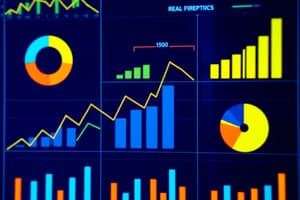Podcast
Questions and Answers
What is the primary purpose of Principal Component Analysis (PCA)?
What is the primary purpose of Principal Component Analysis (PCA)?
- To reduce data dimensionality while retaining most information (correct)
- To eliminate noise from datasets
- To increase data dimensionality for better analysis
- To categorize data into discrete classes
Which of the following best describes the process of Self-Training in Semi-Supervised Learning?
Which of the following best describes the process of Self-Training in Semi-Supervised Learning?
- It only updates the model using labeled data without external inputs
- It trains only on unlabeled data to avoid bias
- It predicts labels for unlabeled data and retrains on the combined dataset (correct)
- It combines data from all sources without differentiation
What distinguishes Deep Q-Networks (DQN) from traditional Q-learning?
What distinguishes Deep Q-Networks (DQN) from traditional Q-learning?
- DQN is strictly limited to low-dimensional state spaces
- DQN cannot be used in robotics and game playing
- DQN does not require any state representations
- DQN combines Q-learning with deep learning to handle complex environments (correct)
Which statement accurately describes regression analysis?
Which statement accurately describes regression analysis?
What is the primary aim of clustering algorithms?
What is the primary aim of clustering algorithms?
What type of analytics focuses on summarizing historical data to provide insights into past events?
What type of analytics focuses on summarizing historical data to provide insights into past events?
Which analytics type seeks to understand the reasons behind past outcomes?
Which analytics type seeks to understand the reasons behind past outcomes?
What is a key characteristic of prescriptive analytics?
What is a key characteristic of prescriptive analytics?
What type of data can take any value within a range and is typically measured?
What type of data can take any value within a range and is typically measured?
Which of the following is an example of discrete data?
Which of the following is an example of discrete data?
What distinguishes ordinal data from nominal data?
What distinguishes ordinal data from nominal data?
How is continuous data often analyzed?
How is continuous data often analyzed?
What question does predictive analytics aim to answer?
What question does predictive analytics aim to answer?
Which analysis technique is commonly applied to ordinal data?
Which analysis technique is commonly applied to ordinal data?
What type of data is characterized by having only two categories?
What type of data is characterized by having only two categories?
What is a primary role of a Data Architect?
What is a primary role of a Data Architect?
Which algorithm is used for extracting data from websites?
Which algorithm is used for extracting data from websites?
What is the main purpose of Optical Character Recognition (OCR)?
What is the main purpose of Optical Character Recognition (OCR)?
Which role is responsible for building and maintaining data infrastructure?
Which role is responsible for building and maintaining data infrastructure?
What is not typically associated with textual data analysis?
What is not typically associated with textual data analysis?
Which method is typically used for collecting structured data from online sources?
Which method is typically used for collecting structured data from online sources?
Which of the following algorithms is primarily used for predicting continuous outcomes?
Which of the following algorithms is primarily used for predicting continuous outcomes?
What is the main function of Data Cleaning Algorithms?
What is the main function of Data Cleaning Algorithms?
Which framework is specifically used for data visualization?
Which framework is specifically used for data visualization?
What can be identified as a primary application of Artificial Neural Networks (ANN)?
What can be identified as a primary application of Artificial Neural Networks (ANN)?
Which of the following best describes a Convolutional Neural Network (CNN)?
Which of the following best describes a Convolutional Neural Network (CNN)?
Which type of learning algorithm uses tree-like models for classification?
Which type of learning algorithm uses tree-like models for classification?
What is a key benefit of using algorithms in predictive modeling?
What is a key benefit of using algorithms in predictive modeling?
Which of the following tools is used for integrating different data sources and systems?
Which of the following tools is used for integrating different data sources and systems?
What is the primary use of Speech Recognition technology?
What is the primary use of Speech Recognition technology?
Which of the following statements about recommendation systems is accurate?
Which of the following statements about recommendation systems is accurate?
What is one of the primary objectives of algorithms in driving innovation?
What is one of the primary objectives of algorithms in driving innovation?
Which algorithm is commonly employed for customer segmentation?
Which algorithm is commonly employed for customer segmentation?
Which type of algorithm specializes in locating and retrieving data from various sources based on specific criteria?
Which type of algorithm specializes in locating and retrieving data from various sources based on specific criteria?
Flashcards are hidden until you start studying
Study Notes
Classifications by Type of Analysis
- Descriptive Analytics focuses on summarizing historical data to reveal patterns, answering "What happened?"
- Diagnostic Analytics explores reasons behind outcomes through techniques like drill-down and correlations, answering "Why did it happen?"
- Predictive Analytics forecasts future events using statistical modeling, addressing "What is likely to happen?" with methods like machine learning.
- Prescriptive Analytics recommends actions to optimize outcomes based on predictions, asking "What should we do?" through complex algorithms.
Quantitative Data Classifications
- Discrete Data consists of countable values like the number of employees or products sold, with analysis using frequency distributions.
- Continuous Data can take any value within a range, examples include temperatures or weight, often analyzed using histograms.
Qualitative Data Classifications
- Nominal Data categorizes without order, such as gender or race, analyzed through frequency counts.
- Ordinal Data represents ranked categories like education levels, with analysis techniques including median calculations.
- Binary Data has two categories, often used in logistic regression.
- Textual Data includes unstructured text from sources like social media, analyzed with natural language processing.
Data Science Roles and Specializations
- Data Strategist aligns data strategies with business goals, seeking innovative opportunities.
- Data Architect designs data structures for efficient storage and integration.
- Data Engineer builds infrastructure for data collection and processing.
- Data Analyst examines data for insights, creating reports and visualizations.
Automating Data Collection, Cleaning, and Analysis
- Web Scraping and Crawling extracts data from websites; API integration collects structured data directly.
- Optical Character Recognition (OCR) converts unstructured data from documents into structured data.
- Data Processing Algorithms include ETL processes to automate data transformation and loading.
Key Technologies and Tools
- AI and ML Frameworks include TensorFlow, PyTorch, and scikit-learn for machine learning tasks.
- Data Processing Frameworks such as Apache Spark handle large-scale data processing.
- Data Visualization Tools like D3.js and Chart.js present data insights visually.
Data Science Algorithms
- Supervised Learning: linear regression predicts continuous outcomes, while logistic regression classifies events.
- Unsupervised Learning: k-means clustering groups similar data, and PCA reduces dimensionality.
- Semi-Supervised Learning: self-training and co-training enhance model performance using labeled and unlabeled data.
- Reinforcement Learning: Q-learning and DQN optimize decision-making in uncertain environments.
Key Applications and Benefits
- Predictive Modeling uses historical data for forecasting outcomes; important for business decisions.
- Classification algorithms categorize data into different classes effectively.
- Recommendation Systems utilize collaborative filtering to suggest products to users based on behavior.
Importance in Data Science
- Automating tasks enhances efficiency and scalability in data processes.
- Algorithms uncover hidden patterns, driving innovation and competitive advantage.
Studying That Suits You
Use AI to generate personalized quizzes and flashcards to suit your learning preferences.




